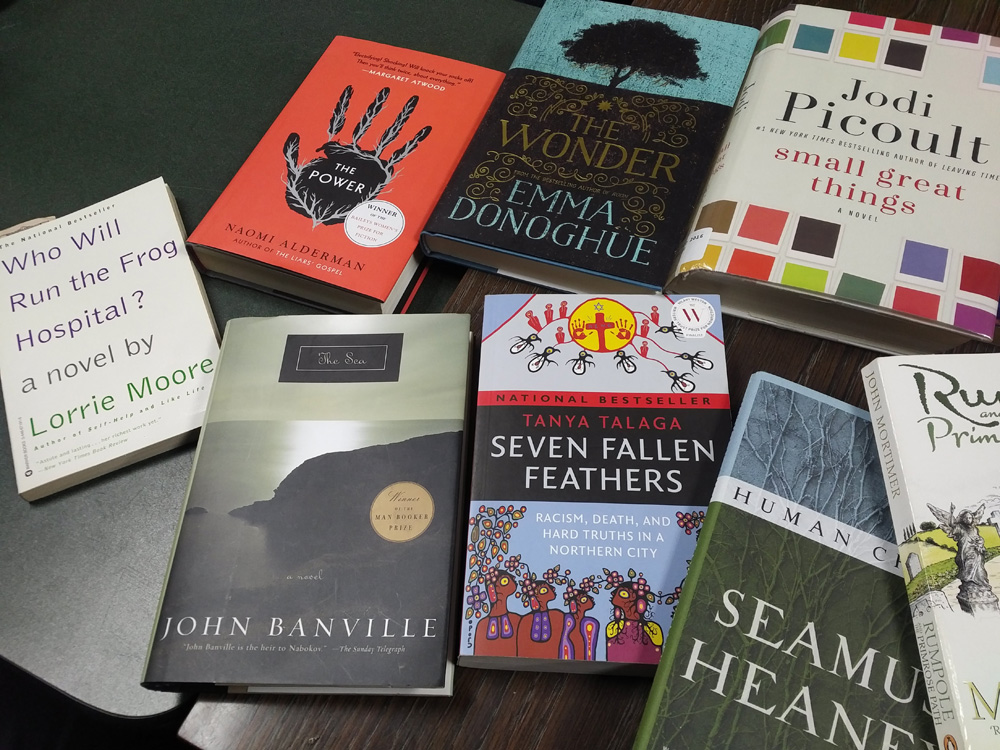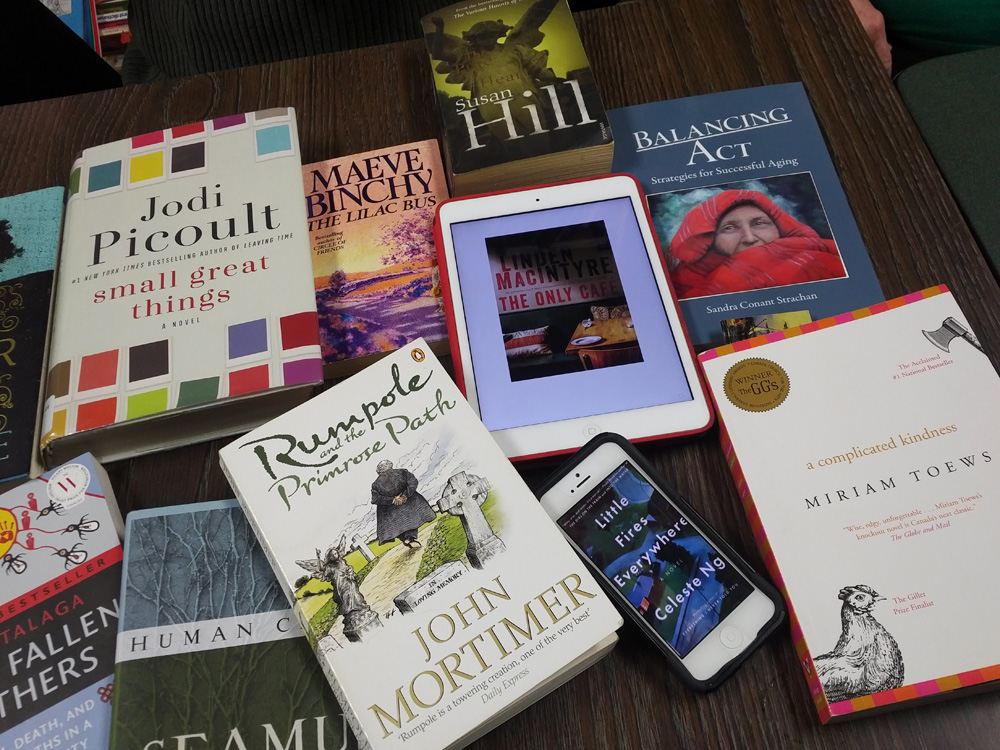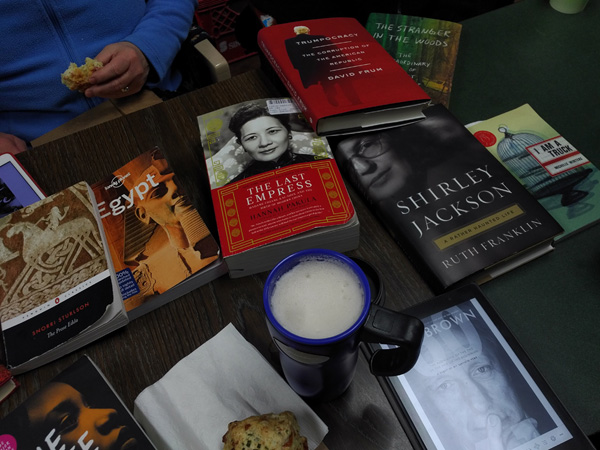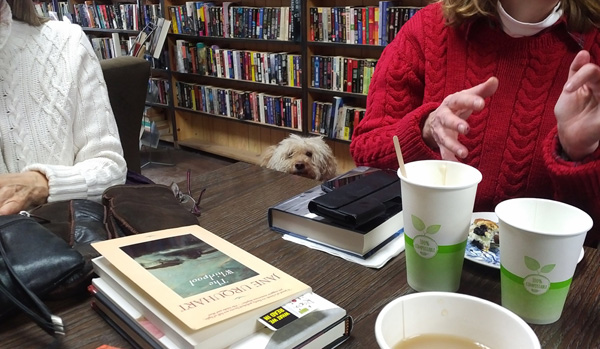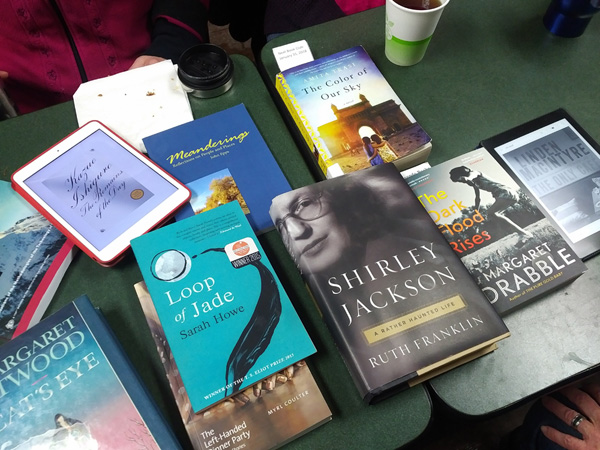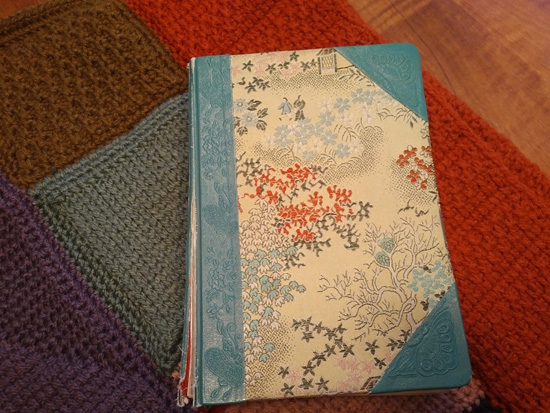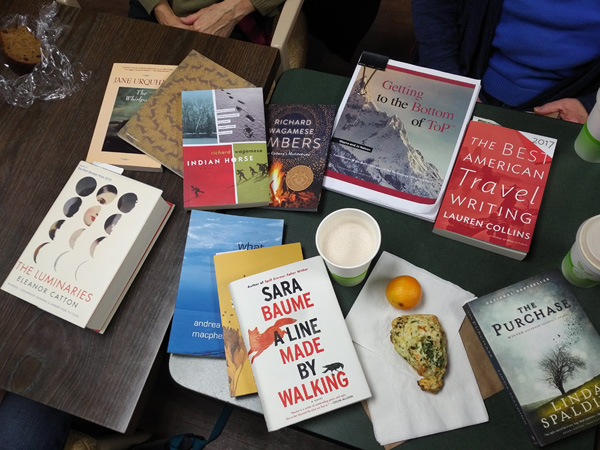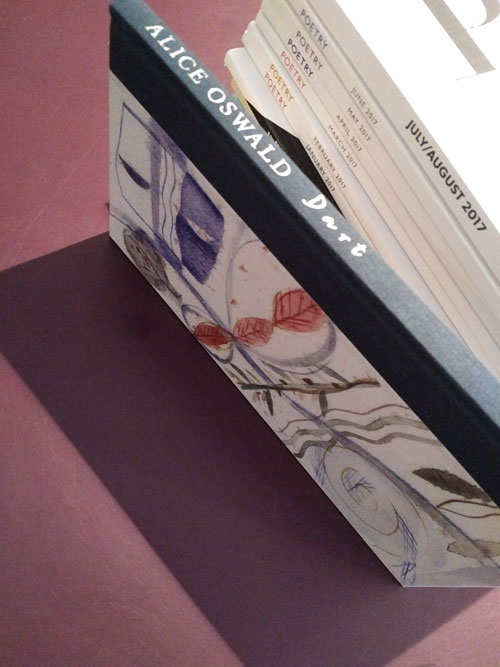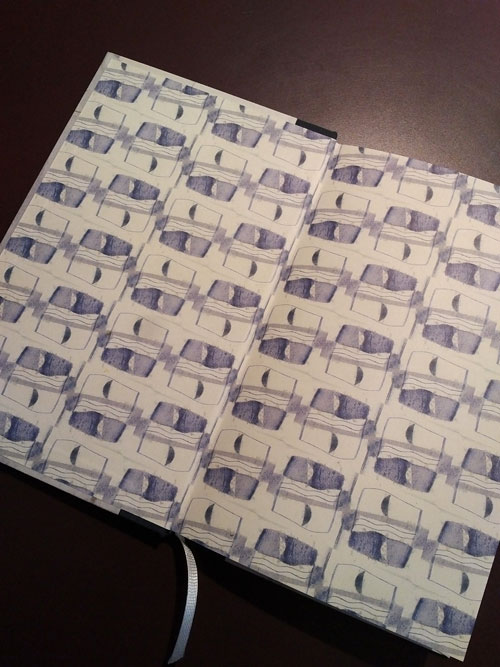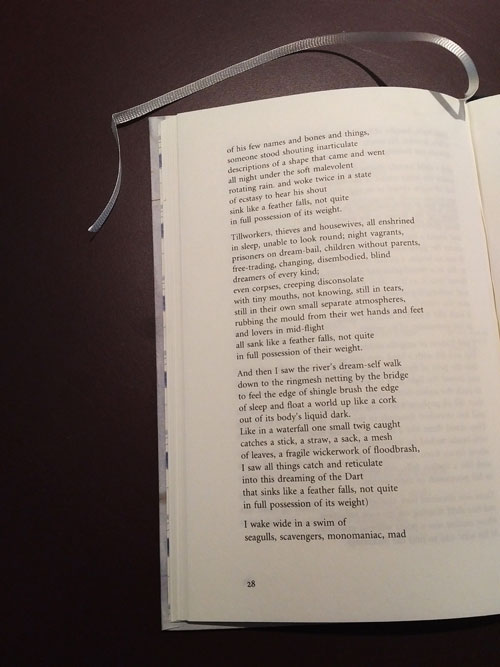Here are the books I read in 2017, with links to reviews where I have them. Again, this is an exhaustive, “all of” list, not a “best of” list.
In recent years, I’ve welcomed some wonderful guest reviewers and correspondents to this blog. I extended some invitations again this past year, but the reviews didn’t come together for various good reasons. I’m going to try again in 2018 to add some guest pieces to the mix here.
Here are the books I read and read aloud in 2017. Wherever I go, I try to carry a book with me, so for each book, I’m also going to try to recall where I was when I was reading it.
-
Being a Dog
by Alexandra Horowitz
(read aloud)
As I’ve mentioned before, a lot of our reading aloud takes place in the kitchen, with my talented husband cooking and me singing for my supper. Quite appropriately, our Airedale terrier Tilly and beagle-basset Jake were often in attendance as I read this particular book.
-
The Small Nouns Crying Faith
by Phil Hall
This poetry collection kept me company on several subway rides.
-
Swing Time
by Zadie Smith
I recall devouring this book pretty quickly, curled up in bed on a few cold winter nights.
-
The Two of Us
by Kathy Page
This short story collection kept me company on several subway and streetcar rides.
-
Dear Sir, I Intend to Burn Your Book
by Lawrence Hill
I read this essay in a couple of sittings at home. I have a home office, and it’s often easy to just fix a quick lunch and eat it at my desk while continuing with my work. I do my best, though, to step away from my desk and computer, eat lunch in the dining room and read a book, magazine article or something not displayed on a screen for a break. I know I read this during one of those lunch breaks.
-
My Brilliant Friend
by Elena Ferrante, translated by Ann Goldstein
… and indeed, this Ferrante quartet took me through the winter and early spring. I read them everywhere.
-
The Very Persistent Gappers of Frip
by George Saunders, illustrated by Lane Smith
I read this gorgeous book at home, carefully, at my desk. Later in the year, I was thrilled to meet George Saunders, and he seemed bemused to see the book when we asked him to sign it.
-
The House on Selkirk Avenue
by Irena Karafilly
I read this novel during several subway rides.
-
Minds of Winter
by Ed O’Loughlin
I initially read this rich, fascinating novel printed out in loose, 8 1/2 x 11 inch printed out pages at my desk in my home office, as I prepared the readers’ guide / book club questions offered by the publisher, House of Anansi Press. I was glad to get a proper bound copy later, as the book boasts a gorgeous cover … and oh, I imagine I’m going to read this one again.
-
The Story of a New Name
by Elena Ferrante, translated by Ann Goldstein
As I mentioned, I read the Ferrante books everywhere.
-
Transit
by Rachel Cusk
I tend to avoid taking hardcover books along when I’m out and about, so I read this book at home, not on transit (nyuk nyuk). I recall having a lovely Twitter conversation about this and Cusk’s previous and related novel, Outline.
-
A
by Andre Alexis
This was a quick read, so I think it might only have accompanied me on one or two subway rides.
-
On Turpentine Lane
by Elinor Lipman
This was a cozy curl-up-with-a-dog-nestled-with-you kind of read.
-
Lincoln in the Bardo
by George Saunders
This was a sit-up-straight-and-pay-attention read, mostly at the dining room table, finished not long before we went to see George Saunders read and be interviewed by the incomparable Eleanor Wachtel at the Toronto Public Library Appel Salon.
-
Believing is not the same as Being Saved
by Lisa Martin
I took my time reading this poetry collection, and transcribed selections from it while sitting at my downstairs office desk.
-
Those Who Leave and Those Who Stay
by Elena Ferrante, translated by Ann Goldstein
Again, I read this everywhere, including by candlelight during Earth Hour.
-
Mitzi Bytes
by Kerry Clare
This novel was definitely a good subway ride companion. I remember being quite absorbed in it and almost missing my stop when heading out one evening to meet friends with whom we were going to a concert.
-
Silvija
by Sandra Ridley
-
Violet Energy Ingots
by Hoa Nguyen
I’m pretty sure I travelled by subway and streetcar with both of these poetry collections in tow, as I finished them within 24 hours of each other.
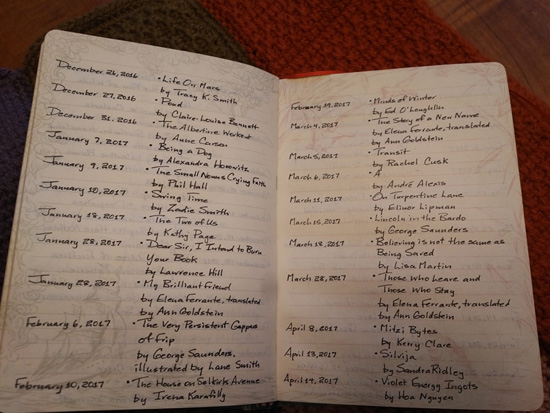
-
The Story of the Lost Child
by Elena Ferrante, translated by Ann Goldstein
In the spring, I bade farewell to these constant book companions.
-
Falling Awake
by Alice Oswald
This poetry collection was often particularly perfect company in my travels around the city.
-
The Lonely Hearts Hotel
by Heather O’Neill
This was another sit-up-straight-and-pay-attention read, again mostly at the dining room table.
-
World of Made and Unmade
by Jane Mead
I remember having this poetry collection with me once or twice when I was out running errands in the neighbourhood.
-
Swallowing Mercury
by Wioletta Greg, translated by Eliza Marciniak
… and then there are the riveting reads that make you forget where you are when you’re reading them …
-
Fever Dream
by Samanta Schweblin, translated by Megan McDowell
Yes, I definitely remember reading this one on the streetcar.
-
The Burgess Shale – The Canadian Writing Landscape of the 1960s
by Margaret Atwood
I remember reading this piece in one sitting at the dining room table.
-
So Much Love
by Rebecca Rosenblum
This novel made some subway and streetcar rides pass very quickly.
-
Hot Milk
by Deborah Levy
I was reading this absorbing novel during our trip to Dublin.
-
A General Theory of Oblivion
by Jose Eduardo Agualusa, translated by Daniel Hahn
We attended the Dublin Literary Award ceremony when we visited Dublin. Right after the ceremony, we walked down the street to Hodges Figgis bookshop and purchased one of the last copies of this book in the shop. I read and finished it on the flight home.
-
Conversations With Friends
by Sally Rooney
This was another excellent Dublin purchase (from Winding Stair bookshop’s local recommendations table) which I also read on the flight home.
-
4321
by Paul Auster
At 800+ pages, this was a fascinating but not at all portable read. I did attempt to read it in bed a few times, but after it tipped over on my sleepy head one too many times, I stuck to reading it on the dining room table.
-
Little Sister
by Barbara Gowdy
This novel was topmost on a stack of cottage reading for one of our first extended cottage stays this summer.
-
Swimming Lessons
by Claire Fuller
Another cottage read …
-
Moanin’ at Midnight – The Life and Times of Howlin’ Wolf
by James Segrest and Mark Hoffman
(read aloud)
We read this one aloud at home and at the cottage, always to a Howlin’ Wolf soundtrack, of course.
-
Nuala
by Kimmy Beach
Another cottage read …
-
spill simmer falter wither
by Sara Baume
Another wonderful purchase from our Ireland trip, I read this one slowly and carefully, both at the cottage and on the back porch in the city.
-
The Pet Radish, Shrunken
by Pearl Pirie
This poetry collection was particularly good company during an extended and somewhat anxious wait for a delayed train at Toronto’s Union Station.
-
Frontier City – Toronto on the Verge of Greatness
by Shawn Micallef
(read aloud)
A lot of this one was read aloud (and thoroughly enjoyed) in our kitchen in, of course, Toronto.
-
The Last Wave
by Gillian Best
I toted this novel all over, reading it at the nails place, at the cottage, out and about …
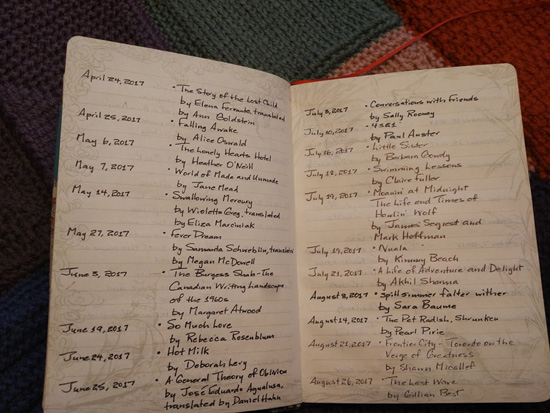
-
England
by Nia Davies
I read this striking chapbook at my home office desk.
-
In the Cage
by Kevin Hardcastle
I had to read this novel and two others (The Prisoner and the Chaplain by Michelle Berry and Men Walking on Water by Emily Schultz) on very short notice to host three book club events at this year’s Toronto Word on the Street book fest. How fortunate that all three books were compelling, infectious reads. I gobbled this one up in about 36 hours at home on a sultry September weekend.
-
The Original Face
by Guillaume Morissette
I remember reading this novel in a parkette near Skydome before meeting my beloved to take in a Blue Jays baseball game.
-
The Prisoner and the Chaplain
by Michelle Berry
-
Men Walking on Water
by Emily Schultz
Toronto’s Word on the Street book fest was on a sweltering day in late September. I’ll remember that, and that the authors and I all managed to wear black clothes that day, and that their books were all superb.
-
Pockets
by Stuart Ross
I read this wee, beautiful book at my home office desk.
-
The Theory of Hummingbirds
by Michelle Kadarusman
I purchased this exquisite book at Toronto’s Word on the Street and started reading it on the streetcar ride home that afternoon.
-
I Am a Truck
by Michelle Winters
This novel was fine company on several subway and streetcar rides.
-
Brother
by David Chariandy
I devoured this book on a cottage weekend.
-
Bellevue Square
by Michael Redhill
This novel was also a cottage read.
-
The Curious History of Irish Dogs
by David Blake Knox
(read aloud)
Another fine purchase from our Ireland trip, this was a great read aloud choice.
-
If Clara
by Martha Baillie
This was meant to be a book suitable for toting along on transit, but I’m pretty sure I read it swiftly at home.
-
Next Year For Sure
by Zoey Leigh Peterson
This book was fine company for our first neighbourhood silent book club meeting.
-
Son of a Trickster
by Eden Robinson
I read this novel at home, on home office lunch breaks.
-
H(A)PPY
by Nicola Barker
I read this singular book at home, giving it my full attention, as Nicola Barker books always demand.
-
No TV For Woodpeckers
by Gary Barwin
I read this poetry collection at home and on the go, and transcribed at least one striking poem into my journal.
-
A Line Made By Walking
by Sara Baume
This book was such good company for our second neighbourhood silent book club meeting.
-
Panicle
by Gillian Sze
Like Gary Barwin’s latest, I read this poetry collection at home and on the go, and transcribed at least one striking poem into my journal.
-
What We Once Believed
by Andrea Macpherson
I read this novel at home and on transit.
-
Glory
by Gillian Wigmore
I pretty much inhaled this novel over the holiday season, at home and at my brother-in-law’s over Christmas.
-
String Practice
by Jan Zwicky
I read this poetry chapbook at my home office desk on the last day of 2017.
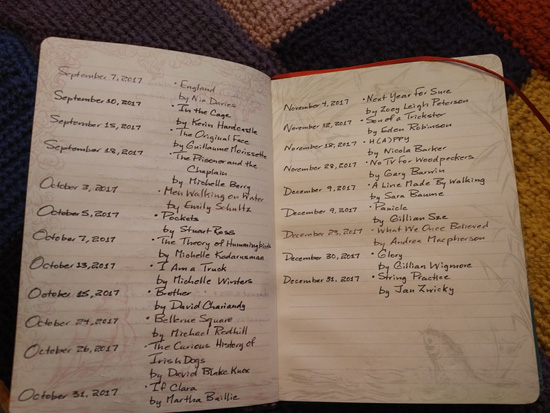
In 2017, I read a total of 60 works (a new record for me): 43 works of fiction (novels and short story collections), 11 poetry collections and 6 works of non-fiction. I did not re-read any books this year (but commit to doing that again in 2018), read 7 works in translation, and read 36 works by Canadian authors. My husband and I read four books aloud to each other this year and have another one in progress as we greet the new year.
I also kept track this year of the publication dates of the books I read. (I think this is fairly easy to track in Goodreads, so I want to go back to previous years to see what my mix of current versus older reading is year over year.) In 2017, the oldest book I read was published in 2000. I also read books published in 2004, 2012, 2013, 2015 and 2016, and more than half of what I read in 2017 was published in that year. Even before I go back and explore publication dates in previous years, I know right now I want to try to read (or re-read) more of a selection of older books in 2018. Let’s see how that works out …
For another year, I’m looking back fondly on my 2017 reading, looking forward eagerly, with anticipation and even some curiosity to my 2018 reading, I’ll simply conclude (as I always do) …


